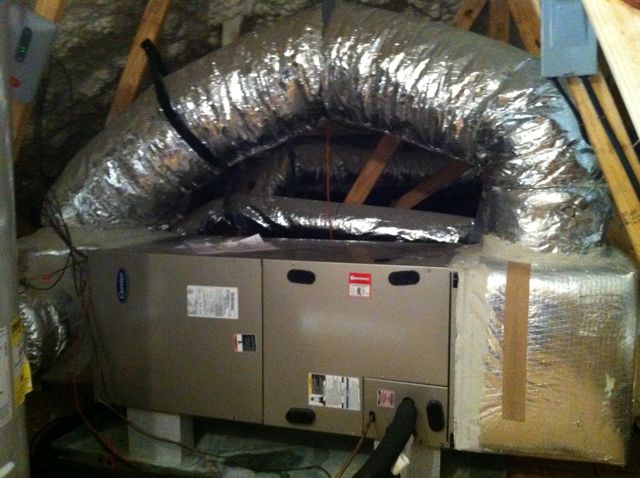
Unless you have a simple, small home, you probably want more than one thermostat to control the heating and cooling. That lets you control the conditions separately in different areas. And that’s where zoning comes in. A common example is a two-story house with one thermostat on each floor. But there’s a lot more to it than just adding thermostats.
Dampers or equipment?
When you adjust a thermostat, it sends a signal that changes the conditions in the area served by that thermostat. It sends more or less conditioned air to that part of the house, depending on which way you adjusted it. But how that happens depends on whether your multiple thermostats are connected to one piece of heating and cooling equipment or one piece of equipment for each thermostat.
In the first case, you have a zoned system. When one thermostat calls for conditioned air, it opens a damper to allow air to flow into the zone that’s calling. Of course, it also has to turn on the heating and cooling system if it’s not already on.
In the other case, the one piece of equipment controlled by a thermostat has only one zone to serve. That keeps things simpler, especially with airflow.
The downside of zoning with dampers
The problem of using dampers on a single piece of equipment is what to do about the airflow. Let’s say you have a heating and cooling system with fixed capacity. It doesn’t have a variable-speed blower. So when, say, only one of two zones is calling for conditioned air, what happens to the excess air the blower is trying to move? Meet the bypass duct.

The most common way installers deal with the excess pressure created when not all zone dampers are open is the bypass duct. It sends air from the high-pressure supply side back to the return plenum. That air re-enters the system having already been conditioned. So it gets colder or hotter with each successive pass. At best, that will reduce the efficiency of the system. At worst, it can freeze the coil in cooling mode or crack a heat exchanger in heating mode.
Good HVAC companies understand that a bypass duct shouldn’t be part of a zoned system. There are ways to do it properly and some good controls available for that purpose. And of course, the first thing to do is use variable-capacity or multi-stage equipment that can ramp up or down depending on the number of zones calling.
Zoning best practices
At Energy Vanguard, we do third-party residential HVAC design all over the U.S. (and a bit outside, too). Nearly every house we do a design for has multiple zones. And most of the time, we have a separate piece of equipment for each zone. Our preference is to zone with equipment rather than dampers.
But we do some designs with zoned systems that have one piece of equipment serving multiple zones. On those jobs, we:
- Use multi-stage or variable capacity equipment.
- Never use bypass ducts!
- Balance the airflow in the zones.
- Allow excess pressure to bleed into dormant zones.
I explained the first two above. Balancing the airflow in the zones means making sure you don’t have a zone that needs a lot less air than the system can ramp down to. For example, if you have a variable-capacity system whose minimum airflow rate is 500 cubic feet per minute (cfm), you shouldn’t have a zone designed for only 150 cfm.
The last tip is advice we pass on about setting the dampers. When a damper closes, it has options for how much it closes. You can set it to close all the way or stay open a little bit. By leaving it open a bit, any excess pressure after the blower ramps down has an escape path…and it’s one that doesn’t have the downsides of the bypass duct.
Smaller zones and multiple thermostats are the way to go for comfort and efficiency. And of course, as I’ve said before, five tons is never the right answer. (Well, almost never.)
________________________________________________________________________
Allison A. Bailes III, PhD is a speaker, writer, building science consultant, and the founder of Energy Vanguard in Decatur, Georgia. He has a doctorate in physics and is the author of a bestselling book on building science. He also writes the Energy Vanguard Blog. For more updates, you can follow Allison on LinkedIn and subscribe to Energy Vanguard’s weekly newsletter and YouTube channel. Images courtesy of author.
Weekly Newsletter
Get building science and energy efficiency advice, plus special offers, in your inbox.















2 Comments
Service Servotech simplifie la compréhension des codes d’erreur des lave-vaisselles LG, offrant un guide étape par étape pour chaque code. Utilisez ces conseils pour entretenir votre appareil efficacement et résoudre les problèmes courants. https://serviceservotech.com/fr/2024/10/code-erreur-lave-vaisselle-lg/
How accurate should these systems be? What is or is not acceptable?
For example, when a zone serves two bedrooms, should both rooms be the same temp or be able to be adjusted/dampered so that one is always x°f hotter or colder (depending on season)? Is it acceptable if one is always 1°f, 2°f or 4°f warmer in winter or colder in summer?
Log in or create an account to post a comment.
Sign up Log in